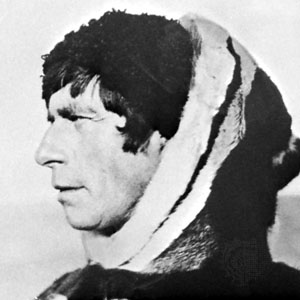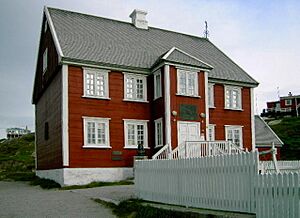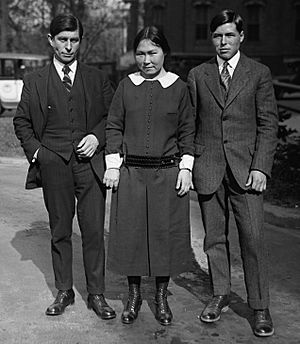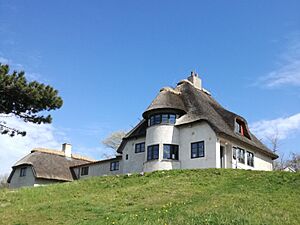Knud Rasmussen facts for kids
Quick facts for kids
Knud Rasmussen
|
|
|---|---|
| Kunuunnguaq | |
 |
|
| Born |
Knud Johan Victor Rasmussen
7 June 1879 Jakobshavn, North Greenland
|
| Died | 21 December 1933 (aged 54) |
| Nationality | Greenlandic-Dane |
| Known for | Polar exploration and eskimology |
| Spouse(s) | Dagmar Andersen |
| Children | Inge Thorborg Niels Rasmussen Hanne Rasmussen |
| Awards |
|
| Scientific career | |
| Fields | Anthropology |
Knud Johan Victor Rasmussen (born June 7, 1879 – died December 21, 1933) was a famous explorer and scientist from Greenland and Denmark. Many people call him the "father of Eskimology" because he studied the Inuit people and their culture so deeply. He was also the first European to travel through the Northwest Passage using a dog sled. Knud Rasmussen is still very well-known in Greenland, Denmark, and among the Canadian Inuit today.
Contents
Early Life and Learning
Knud Rasmussen was born in Jakobshavn, Greenland. His father, Christian Rasmussen, was a Danish missionary, and his mother, Lovise Rasmussen, was part Inuit and part Danish. He grew up with two siblings.
Knud spent his childhood in Greenland. There, he learned to speak Kalaallisut, which is the language of the native Greenlanders. He also learned important skills like hunting, driving dog sleds, and surviving in the very cold Arctic environment. He once said that playing and working with hunters made even the hardest sled trips enjoyable for him.
Later, he went to school in Lynge, in North Zealand, Denmark. For a short time between 1898 and 1900, he tried to become an actor and opera singer, but it didn't work out.
Knud Rasmussen's Career
Knud Rasmussen's first big adventure was an expedition from 1902 to 1904. It was called The Danish Literary Expedition. He traveled with friends like Jørgen Brønlund and Ludvig Mylius-Erichsen. Their goal was to learn more about the Inuit culture.
When he returned home, he gave many talks about his travels. He also wrote a book called The People of the Polar North (1908). This book was a mix of his travel diary and a scientific look at Inuit stories and traditions. In 1908, he married Dagmar Andersen.
In 1910, Rasmussen and his friend Peter Freuchen started the Thule Trading Station. It was located at Cape York (Qaanaaq) in Greenland. They chose the name Thule because it was the most northern trading post in the world, like the "Ultima Thule" or "farthest place." This station became the starting point for seven major trips, known as the Thule Expeditions, which took place between 1912 and 1933.
The Thule Expeditions
First Thule Expedition (1912)
The First Thule Expedition involved Rasmussen and Freuchen. They wanted to check if Robert Peary was right about a channel separating Peary Land from Greenland. They proved he was wrong by traveling 1,000 kilometres (620 mi) across the ice. This journey was incredibly tough and almost cost them their lives. The president of the Royal Geographical Society called it the "finest ever performed by dogs." Freuchen wrote about this trip in his books Vagrant Viking (1953) and I Sailed with Rasmussen (1958).
Second Thule Expedition (1916–1918)
The Second Thule Expedition was a larger trip with seven men. Their goal was to map a part of Greenland's northern coast that was not well known. Rasmussen wrote about this journey in his book Greenland by the Polar Sea (1921). Sadly, two people died during this trip, Thorild Wulff and Hendrik Olsen. These were the only deaths in all of Rasmussen's expeditions.
Later Thule Expeditions
- The Third Thule Expedition (1919) was about setting up supply points for Roald Amundsen's polar journey in his ship, Maud.
- The Fourth Thule Expedition (1919–1920) took Rasmussen to eastern Greenland. He spent several months near Angmagssalik, gathering information about the local culture.
The Great Fifth Thule Expedition (1921–1924)
Rasmussen's biggest achievement was the Fifth Thule Expedition. It was designed to find out about the "origin of the Eskimo race." A huge amount of information was collected, covering culture, history, and biology. This information filled ten books, titled The Fifth Thule Expedition 1921–1924 (1946). Many items collected are still shown in museums in Denmark.
The team of seven first went to eastern Arctic Canada. There, they started collecting items, interviewing people (including the shaman Aua), and digging up old sites.
Rasmussen then left the main team. He traveled for 16 months with two Inuit hunters by dog sled all the way across North America to Nome, Alaska. He wanted to continue to Russia, but he was not allowed to enter the country. He became the first European to cross the Northwest Passage using a dog sled. His journey is described in his book Across Arctic America (1927). This book is now seen as a classic story of polar exploration. This amazing trip is also known as the "Great Sled Journey." It was even made into a Canadian film in 2006 called The Journals of Knud Rasmussen.
For the next seven years, Rasmussen traveled between Greenland and Denmark. He gave many lectures and continued to write. In 1931, he went on the Sixth Thule Expedition. This trip was meant to help Denmark keep its claim on a part of eastern Greenland that Norway was also claiming.
Final Expedition and Death
The Seventh Thule Expedition (1933) was planned to continue the work of the sixth. However, Rasmussen became ill after eating some traditional food called kiviaq. He got pneumonia and died a few weeks later in Copenhagen at the age of 54. During this last expedition, Rasmussen was working on a film called The Wedding of Palo. He wrote the story for the film, which was finished in 1934 under the Danish title Palos brudefærd.
Honors and Recognition
Many places in Greenland are named after Knud Rasmussen, including several capes and glaciers. The Knud Rasmussen Range in Greenland is also named in his honor.
He received many awards for his work:
- In 1912, he was given an Honorary Fellowship from the American Geographical Society.
- In 1924, he received the Daly Medal from the American Geographical Society.
- The Royal Geographical Society gave him their Founder's Gold Medal in 1923.
- The Royal Danish Geographical Society awarded him their Hans Egede Medal in 1924.
- He was also given honorary doctor degrees from the University of Copenhagen in 1924 and the University of St Andrews in 1927.
See also
 In Spanish: Knud Rasmussen para niños
In Spanish: Knud Rasmussen para niños




